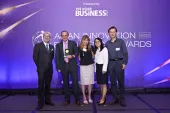
Personalised patient experience depends on proper tech adoption
Connected healthcare allows for better decision-making and processing of body functions.
For VMWare Director - Healthcare APJ Siddhartha Mishra, who has led healthcare, digital healthcare, and business consulting practices in APJ, the Middle East, India, and the USA, many healthcare organisations that aim to shift to digital to meet patient demands need to face significant obstacles in the industry.
As this venture towards digitalisation is fairly new in the industry, the maturity of many of the technology-enabled solutions is yet to be proven. The director pointed out that models are still to be proved for scaling adoption.
At the same time, digital therapeutics or prescribing applications for patient virtual care have no single regulatory authority. He noted that this makes it difficult to absorb the knowledge and usage of healthcare applications across the borders, leading to disruption in cost-benefit equations for business owners as they need to have regulatory approvals for every country they want to operate in and budget the approval cost.
Siddhartha also acknowledged that providers are still struggling with the adoption of technology in various parts and different geographies, with some countries leading more than others.
“There is definitely a demographic push in [the] community for various countries to adopt technology for better care. In developing countries, providers are still not allocating enough budget to procure technology and put it in use,” he said.
Moreover, public healthcare and corporate healthcare have heated the competitive environment. Siddhartha observed that governments have realised that technology adoption is the only way forwards for reach, scale, and size.
“They are pushing the envelope to reduce spend[ing] on building hospitals, but develop new patient engagement models. Whereas, corporate healthcare has a need to retain patients,” he said.
Siddhartha, who has over 24 years of experience in the industry, has helped both private and public healthcare delivery systems successfully navigate complex business transformation journeys. With this experience, he has provided insights on the strategies that healthcare organisations can leverage to address the obstacles.
Amongst this strategy is the continued practice of digital therapeutics and technology-enabled care delivery. Digital adoption of virtual healthcare services by the provider landscape has solicited massive technology chaos–which spans the operations, cost, efficiency & outcome. The provider industry is currently challenged with bringing all these interim digital transformations to consolidation and scale.
“This leads to [the] evolution of heterogeneous care delivery models. Now, rather than a single EMR application streaming data for patient care, there are multiple virtual care apps, case management apps and devices, pooling the set of clinical data,” Siddhartha said, adding that provider organisations would be forced to streamline this using a multichannel or omnichannel care delivery model.
Another strategy which can be implemented is the technology to enhance the intervention and care for patients, utilising virtual care. The director noted that medical consultations and tests are now marching towards connected healthcare.
“Connected healthcare devices are now achieving a major milestone by becoming more cognitive. In essence, these devices are able to perceive and react, process and understand the body functions; store large amounts of data sets and make appropriate decisions,” he said.
‘Inevitable gap’ in delivering healthcare
Siddhartha also observed a familiar complaint echoed across health systems nationwide, which is the inevitable gap in the ability to deliver care safely and to scale businesses amidst physician dissatisfaction, combined with a dwindling clinical education supply.
He also pointed out that there is a projected shortage of around 100,000 physicians by 2030, and with other clinical and non-clinical professions going even worse. “Whilst the gaps will differ by state, and even by town, hospital and health system administrators will struggle over the next decade to staff key positions in an environment of cost constraints,” Siddhartha said.
To handle these challenges, he advised organisations should move out of traditional office spaces, make hospital spaces more revenue-generating than cost centres, shift to value and new care models, digitally enable the workforce, define roles and reassign responsibilities.
As one of the speakers at the Future of Work 4.0 in Hospitals webinar, Siddhartha explored how healthcare organisations can improve their digitalisation journey in order to modernise cloud and application infrastructure to jump into the digital-first future of healthcare.
VMware Senior Director, End User Computing Asia Pacific and Japan Jai Sahney affirmed Siddhartha’s thoughts on this, adding that even the population that are not the most tech-friendly can still catch up on the advancements that are happening in the industry.
“I think the people and process part is very, very important from a future work perspective, giving them flexibility, starting innovative teams and empowering them to make decisions that are important,” he said.
Jai, who is also amongst the panellists in the webinar, is responsible for building and executing strategies to grow VMware’s end-user computing business in the region. He helps organisations realise the full potential of their workforce through VMware’s digital workplace solutions.



















 Advertise
Advertise








